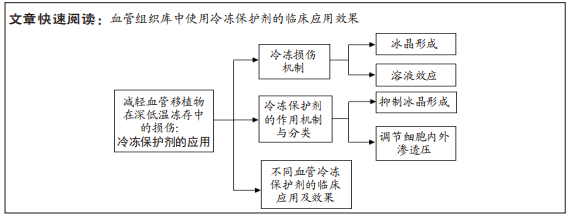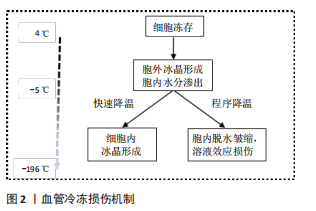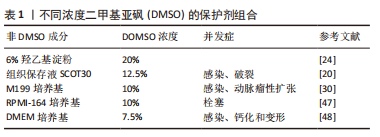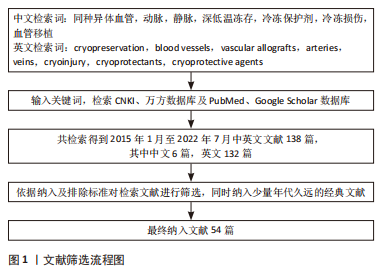[1] VICENTE D, HERNÁNDEZ B, SEGURA V, et al. Methodological Approach to Use Fresh and Cryopreserved Vessels as Tools to Analyze Pharmacological Modulation of the Angiogenic Growth. J Cardiovasc Pharmacol. 2016;68(3): 230-240.
[2] MALLIS P, KATSIMPOULAS M, KOSTAKIS A, et al. Vitrified Human Umbilical Arteries as Potential Grafts for Vascular Tissue Engineering. Tissue Eng Regen Med. 2020;7:285-299.
[3] MASABNI K, WEAVER MR, KANDAGATLA P, et al. Cryopreserved Allograft in the Management of Native and Prosthetic Aortic Infections. Ann Vasc Surg. 2019;56:1-10.
[4] NOVOTN R, MRICKA P, CHLUPAC J, et al. The Effect of Different Thawing Rate on Cryopreserved Human Iliac Arteries Allograft’s Structural Damage and Mechanical Properties. Biomed Res Int. 2020;2020:6545190.
[5] GONZÁLEZ-GAY M, LÓPEZ-MARTÍNEZ R, BUSTO-SUÁREZ S, et al. Immunological Aspects Involved in the Degeneration of Cryopreserved Arterial Allografts. Front Surg. 2020;7:616654.
[6] RAJU R, BRYANT SJ, WILKINSON BL, et al. The need for novel cryoprotectants and cryopreservation protocols: Insights into the importance of biophysical investigation and cell permeability. Biochim Biophys Acta Gen Subj. 2021; 1865:129749.
[7] BURLAGE LC, TESSIER SN, ETRA JW, et al. Advances in machine perfusion, organ preservation,and cryobiology: potential impact on vascularized composite allotransplantation. Curr Opin Organ Transplant. 2018;23:561-567.
[8] WHALEY D, DAMYAR K, WITEK RP, et al. Cryopreservation: An Overview of Principles and Cell-Specific Considerations. Cell Transplant. 2021;30(1): 963689721999617.
[9] CHANG T, ZHAO G. Ice Inhibition for Cryopreservation: Materials, Strategies, and Challenges. Adv Sci (Weinh). 2021;8:2002425.
[10] MAZUR P, LEIBO SP, CHU E. A two-factor hypothesis of freezing injury. Evidence from Chinese hamster tissue-culture cells. Exp Cell Res. 1972; 71(2):345-355.
[11] SHANI N, FRIEDMAN O, ARAV A, et al. Cryopreservation and Transplantation of Vascularized Composite Transplants: Unique Challenges and Opportunities. Plast Reconstr Surg. 2019;143(5):1074e-1080e.
[12] SHU Z, GAO D, PU L. Update on Cryopreservation of Adipose Tissue and Adipose-derived Stem Cells. Clin Plast Surg. 2015;42(2):209-218.
[13] PEGG DE. The relevance of ice crystal formation for the cryopreservation of tissues and organs. Cryobiology. 2020;93:3-11.
[14] RAJAN R, MATSUMURA K. Development and Application of Cryoprotectants. Adv Exp Med Biol. 2018;1081:339-354.
[15] BAUST JM, CORWIN W, SNYDER KK, et al. Cryopreservation: Evolution of Molecular Based Strategies. Adv Exp Med Biol. 2016;951:13-29.
[16] MĚŘIČKA P, JANOUŠEK L, BENDA A, et al. Cell Viability Assessment Using Fluorescence Vital Dyes and Confocal Microscopy in Evaluating Freezing and Thawing Protocols Used in Cryopreservation of Allogeneic Venous Grafts. Int J Mol Sci. 2021;22(19):10653.
[17] LIN CC, LI HH, TSAI SW, et al. Tissue Cryopreservation and Cryobanking: Establishment of a Cryogenic Resource for Coral Reefs. Biopreserv Biobank. 2022;20(4):409-411.
[18] HUNT CJ, SONG YC, BATESON E, et al. Fractures in Cryopreserved Arteries. Cryobiology. 1994;31(5):506-515.
[19] NOVOTNY R, SLIZOVA D, HLUBOCKY J, et al. Cryopreserved human aortic root allografts arterial wall: Structural changes occurring during thawing. Plos One. 2017;12(4):e0175007.
[20] COUTURE T, GAUDRIC J, DU MONTCEL ST, et al. Short and Mid Term Outcomes of Cryopreserved Abdominal Aortic Allografts Used as a Substitute for Infected Prosthetic Grafts in 200 Patients. Eur J Vasc Endovasc Surg. 2021;62(1):89-97.
[21] WEISS S, BACHOFEN B, WIDMER MK, et al. Long-term results of cryopreserved allografts in aortoiliac graft infections. J Vasc Surg. 2021; 74(1):268-275.
[22] BEN AHMED S, LOUVANCOURT A, DANIEL G, et al. Cryopreserved arterial allografts for in situ reconstruction of abdominal aortic native or secondary graft infection. J Vasc Surg. 2018;67(2):468-477.
[23] SHAHMANSOURI N, CARTIER R, MONGRAIN R. Characterization of the toughness and elastic properties of fresh and cryopreserved arteries. J Biomech. 2015;48(10):2205-2209.
[24] HRUBY J, SPUNDA R, MERICKA P, et al. Influence of the new standardized clinical cryopreservation/slow thawing protocol on immunogenicity of arterial allografts in rats. PLoS ONE. 2020;15(3):e0230234.
[25] HEO SH, KIM YW, WOO SY, et al. Recent Results of In Situ Abdominal Aortic Reconstruction with Cryopreserved Arterial Allograft. Eur J Vasc Endovasc Surg. 2017;53(2):158-167.
[26] TOUMA J, COCHENNEC F, PARISOT J, et al. In Situ Reconstruction in Native and Prosthetic Aortic Infections Using Cryopreserved Arterial Allografts. Eur J Vasc Endovasc Surg. 2014;48(3):292-299.
[27] KIM JH, CHHAI P, RHEE K. Development and characterization of viscoelastic polydimethylsiloxane phantoms for simulating arterial wall motion. Med Eng Phys. 2021;91:12-18.
[28] ANTONOPOULOS CN, PAPAKONSTANTINOU NA, HARDY D, et al. Editor’s Choice - Cryopreserved Allografts for Arterial Reconstruction after Aorto-Iliac Infection: A Systematic Review and Meta-Analysis. Eur J Vasc Endovasc Surg. 2019;58:120-128.
[29] LEJAY A, DELAY C, GIRSOWICZ E, et al. Cryopreserved Cadaveric Arterial Allograft for Arterial Reconstruction in Patients with Prosthetic Infection. Eur J Vasc Endovasc Surg. 2017;54:636-644.
[30] GOLEMOVIC M, SKIFIC M, HALUZAN D, et al. Ten-year experience with cryopreserved vascular allografts in the Croatian Cardiovascular Tissue Bank. Cell Tissue Bank. 2022:1-18. doi: 10.1007/s10561-022-09992-6.
[31] ALEXANDER Y, OSTO E, SCHMIDT-TRUCKSÄSS A, et al. Endothelial function in cardiovascular medicine: a consensus paper of the European Society of Cardiology Working Groups on Atherosclerosis and Vascular Biology, Aorta and Peripheral Vascular Diseases, Coronary Pathophysiology and Microcirculation,and Thrombosis. Cardiovasc Res. 2021;117(1):29-42.
[32] LOPEZ MJ. Creative technology advances tissue preservation. Ann Transl Med. 2017;5(23):463.
[33] CHANG SK, LAU JW, CHUI CK. Changes in mechanical,structural integrity and microbiological properties following cryopreservation of human cadaveric iliac arteries. Ann Acad Med Singap. 2014;43(10):492-498.
[34] GORE M, NARVEKAR A, BHAGWAT A, et al. Macromolecular cryoprotectants for the preservation of mammalian cell culture: lessons from crowding, overview and perspectives. J Mater Chem B. 2022;10(2):143-169.
[35] JOSEPH B. The cryopreservation of composite tissues: Principles and recent advancement on cryopreservation of different type of tissues. Organogenesis. 2009;5(3):119-126.
[36] HE B, SU S, YUAN G, et al. Clinical guideline for vascularized composite tissue cryopreservation. J Tissue Eng Regen Med. 2021;15(6):527-533.
[37] AWAN M, BURIAK I, FLECK R, et al. Dimethyl sulfoxide: a central player since the dawn of cryobiology,is efficacy balanced by toxicity? Regen Med. 2020;15(1):1463-1491.
[38] JASHARI R, VAN HOECK B, NGAKAM R, et al. Banking of cryopreserved arterial allografts in Europe: 20 years of operation in the European Homograft Bank (EHB) in Brussels. Cell Tissue Bank. 2013;14:589-99.
[39] ŠPAČEK M, MĚŘIČKA P, JANOUŠEK L, et al. Current vascular allograft procurement, cryopreservation and transplantation techniques in the Czech Republic. Adv Clin Exp Med. 2019;28(4):529-534.
[40] HEINOLA I, KANTONEN I, JAROMA M, et al. Editor’s Choice - Treatment of Aortic Prosthesis Infections by Graft Removal and In Situ Replacement with Autologous Femoral Veins and Fascial Strengthening. Eur J Vasc Endovasc Surg. 2016;51:232-239.
[41] CHAKFÉ N, DIENER H, LEJAY A, et al. Editor’s Choice - European Society for Vascular Surgery (ESVS) 2020 Clinical Practice Guidelines on the Management of Vascular Graft and Endograft Infections. Eur J Vasc Endovasc Surg. 2020;59:339-384.
[42] HARLANDER-LOCKE MP, HARMON LK, LAWRENCE PF, et al. The use of cryopreserved aortoiliac allograft for aortic reconstruction in the United States. J Vasc Surg. 2014;59(3):669-674.
[43] MATIA I, ADAMEC M, VARGA M, et al. Aortoiliac reconstruction with allograft and kidney transplantation as a one-stage procedure: long term results. Eur J Vasc Endovasc Surg. 2008;35:353-357.
[44] RODRÍGUEZ M, PASCUAL G, PÉREZ-KÖHLER B, et al. Immune response to the long-term grafting of cryopreserved small-diameter arterial allografts. Histol Histopathol. 2012;27(7):873-884.
[45] MITRUS I, SMAGUR A, FIDYK W, et al. Reduction of DMSO concentration in cryopreservation mixture from 10% to 7.5% and 5% has no impact on engraftment after autologous peripheral blood stem cell transplantation: results of a prospective, randomized study. Bone Marrow Transplant. 2018; 53(3):274-280.
[46] MINGA LOWAMPA E, HOLEMANS CH, STIENNON L, et al. Late Fate of Cryopreserved Arterial Allografts. Eur J Vasc Endovasc Surg. 2016;52: 696-702.
[47] PARK GC, HWANG S, JUNG DH, et al. Refined surgical techniques to improve the patency of cryopreserved iliac artery homografts for middle hepatic vein reconstruction during living donor liver transplantation. Ann Surg Treat Res. 2020;99(5):294-304.
[48] GEORGES G, ALLARD B, DAKKAK M, et al. Appraising 5 Years in Activity of the Largest Public Canadian Vascular Graft Bank. J Vasc Surg. 2021;74(3):972-978.
[49] ROGULSKA O, PETRENKO Y, PETRENKO A. DMSO-free cryopreservation of adipose-derived mesenchymal stromal cells: expansion medium affects post-thaw survival. Cytotechnology. 2017;69(2):265-276.
[50] YI XY, LIU MX, LUO Q, et al. Toxic effects of dimethyl sulfoxide on red blood cells, platelets, and vascular endothelial cells in vitro. FEBS Open Bio. 2017; 7:485-494.
[51] 李苗,王丽丽,常冰梅.血管内皮细胞功能损伤机制的研究进展[J].中国动脉硬化杂志,2019,27(8):730-736.
[52] SAKALIHASAN N, MICHEL JB, KATSARGYRIS A, et al. Abdominal aortic aneurysms. Nat Rev Dis Primers. 2018;4:34.
[53] MENNA C, ANDREETTI C, IBRAHIM M, et al. Successful Total Tracheal Replacement by Cryopreserved Aortic Allograft in a Patient Post-COVID-19 Infection. Chest. 2021;160(6):e613-e617.
[54] MARTINOD E, CHOUAHNIA K, RADU DM, et al. Feasibility of Bioengineered Tracheal and Bronchial Reconstruction Using Stented Aortic Matrices. JAMA. 2018;319(21):2212-2222.
|




